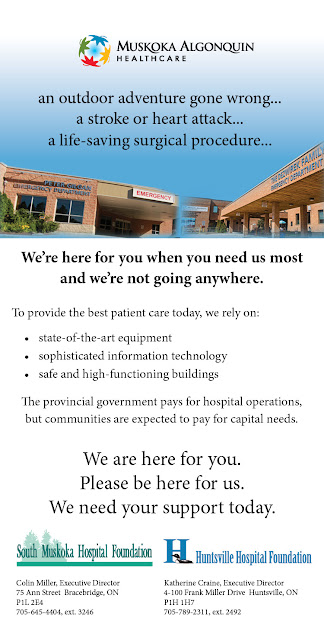Earlier this month, we announced news that Muskoka Algonquin
Healthcare received approval from the Health Capital Investment Branch of the Ministry
of Health and Long-Term Care to proceed with Stage 1 Proposal planning. Stage 1
is one of five distinct stages in the Ministry’s capital planning process for redeveloping
hospitals, and builds on the future planning work that MAHC began in 2012. We
know the importance of having a defined plan for hospital care for future
generations. We have aging buildings and failing infrastructure that require
tens of millions of dollars today to meet evolving health care standards for
safe and high-quality care. We want to be making sound investments and
decisions that are in sync with a recognized and supported plan for the future.
What is Stage 1? The Stage 1 Proposal will further explore and evaluate
development options for a future model of hospital care. It positions MAHC to
move forward with more detailed planning and further analysis of the different
models presented in MAHC's Pre-Capital Submission in 2015. The Pre-Capital Submission is
essentially a 15-page template that poses a number of questions we answered to
paint a picture of MAHC's role as a health care provider in the local health
system. What most people remember about our Pre-Capital is a single site
service delivery model recommended by the MAHC Board of Directors to ensure the
best quality, safety and sustainability of acute care services in the region.
While the Stage 1 planning will continue to build on MAHC’s future planning
work, it doesn’t mean the Board will reach the same conclusion that one
hospital is the best model for the future. The Ministry expects that we will
give further consideration to the use of one or both of the current hospital
sites. And, to quote MAHC’s Board Chair Evelyn Brown, “the world has changed.”
So how will planning for the future be different this time?
Quite simply it’s like writing a new chapter in a novel about the future. The
slate is blank to some extent. A lot has changed since we started our planning
work five years ago, such as:
Patients First Act
Introduced by Ministry of Health Eric Hoskins as Bill 41,
the Patients First Act became law in 2016. Changes supported by the new
legislation will improve local connections between primary care providers,
inter-professional health care teams, hospitals, public health and home and
community care to ensure a smoother patient experience and transitions. Once
fully implemented, there is no doubt these changes will impact the role of
acute care hospitals across the province.
MAHST (Muskoka and
Area Health System Transformation)
The MAHST initiative has been looking at an overall transformation
of the Muskoka health system that aims to achieve better health, better care,
better value and better experience through an integrated health structure where
one overall body is responsible for delivering health care across the entire region.
The outcome of this redesign will have far reaching impact, including how
easily people can access community primary care to how they rely on hospital
for emergency and acute care needs. MAHC is keen to continue engaging the right
people to build on MAHC’s future planning work and MAHST’s local health system
transformation work as we have always believed that MAHST’s findings will have
a significant influence on shaping future acute care in Muskoka.
Capital Plan
Development Task Force
The MAHC Capital Plan Development Task Force will oversee
the Stage 1 Proposal work and recommend a preferred model for the future to the
MAHC Board. This task force will have very broad membership, including members
of the MAHC Board, administration and medical staff, hospital foundations and
auxiliaries, primary care, municipal representatives from the District of
Muskoka, North and South Muskoka and East Parry Sound, MAHST, the North Simcoe
Muskoka LHIN, and the greater Muskoka community. We are committed to continue
working collaboratively with key stakeholders and facilitating extensive
community engagement throughout the Stage 1 work.
Projections –
Population, Beds, Services
There will be new population data available to us through
the 2016 census. As well, projections in MAHC’s Pre-Capital were based on
planning horizons that were five years, 10 years and 20 years from when we
began compiling data in 2014/15. Our new baseline for data will be the 2016/17
fiscal year, and looking out eight years to 2024/25, 15 years to 2031/32, 20
years to 2036/37 and 30 years to 2046/47. We have always committed to
ever-greening and refining any proposal for the future so that it reflects the
most current information available.
Innovation and Technology
Five years ago no one was talking about self-driving cars,
and now this technology is so close to being realized that every major
automotive manufacturer has one ready to hit the market. In the recent years,
telemedicine through videoconferencing has changed how we can access
specialists without driving to the big city where they are based. We’re likely not
far from a more digital world of health care where 3D printing, handheld
ultrasound, and digital medical wireless devices that can check your vital
signs are commonplace. Innovation and technology will greatly impact how care
is provided by hospitals in the future.
So in writing a new chapter about the future, I want to
reinforce there are no preconceived notions. No decisions made. We are starting
with a clean slate to some extent, building on past work to find a solution for
the future that we can all support and get behind. Our future is bright.
Continue this journey with us and stay updated through our website at www.mahc.ca/planning-for-the-future.



